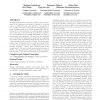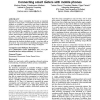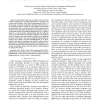21 search results - page 1 / 5 » Leveraging smart phones to reduce mobility footprints |
MOBISYS
2009
ACM
14 years 5 months ago
2009
ACM
Mobility footprint refers to the size, weight, and energy demand of the hardware that must be carried by a mobile user to be effective at any time and place. The ideal of a zero m...
MUM
2009
ACM
13 years 11 months ago
2009
ACM
Reducing their energy consumption has become an important objective for many people. Consumption transparency and timely feedback are essential to support those who want to adjust...
PPPJ
2009
ACM
13 years 9 months ago
2009
ACM
The usage of cellular phones, PDAs, and other mobile devices has increased dramatically over the past ten years. Java is targeted to be one of the most popular execution environme...
IACR
2011
12 years 4 months ago
2011
—Contactless technology is widely used in security sensitive applications, including identification, payment and access-control systems. Near Field Communication (NFC) is a shor...
SOCIALCOM
2010
13 years 2 months ago
2010
Smart phones can collect and share Bluetooth co-location traces to identify ad hoc or semi-permanent social groups. This information, known to group members but otherwise unavailab...



